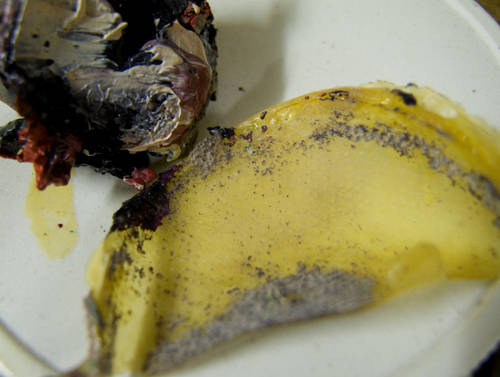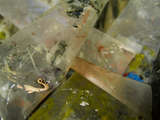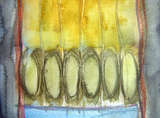some strange studio stuff
1/31
it's not something gross,
and i think i actually know what it is
(i know, it's my studio & i shot it)
without checking:
the dark thing is a stub of a black oil stick that has other colors of paint encrusted into it (sloppy, sloppy work habits)
and the light thing must be the skin of some type of medium that i needed to peal off because it hadn't been used in so long (bad, bad work habits)
anyway in addition to all the internal stuff i did that resulted in my getting back into the studio, i had a little push from the outside that i would like to share with you.
this is a slightly edited version of today's issue of a news letter that i get in my email twice a week. It is from robert genn who has a site: painter's keys geared towards representational painters. that said, while there are some topics covered that are of little interest to me, i would say 80% is very useful/inspirational and i think at least 70% would be valuable to anyone who is involved in the creative process, especially if it's visual.
so what i am really suggesting is that you might try subscribing...
". . . The mark you have made determines the mark you
make. In the words of painter and instructor Charles Reid, "Let
the painting tell you what it needs.". . .
A work of art, like a Rubik's cube, has a billion
routes. And our chances of creative variety are greatest when
we are prepared to bluff. This act implies that our current
hand has higher value than might immediately be evident. Fact
is, it has. This little bit of self-deception is a key to
creative flow and inventive imagery. It's also the key to
keeping ourselves interested in the process--in the production
of the art. Withholding, subterfuge, surprise, deception and
curiosity drive to a possible trump.
I also. . . was thinking how much this business
depends on immersion. The mathematician John Littlewood, in his
"Miscellany," determined that immersion was the most important
factor in creative invention. In his findings, creative minds
need to spend a long time thinking hard, working on and
rejecting permutations and combinations--often getting
nowhere--before they start to be regularly blessed with winning
hands. If I truly knew how to speed up your game, I would let
you know right here and now, but I don't."
it's not something gross,
and i think i actually know what it is
(i know, it's my studio & i shot it)
without checking:
the dark thing is a stub of a black oil stick that has other colors of paint encrusted into it (sloppy, sloppy work habits)
and the light thing must be the skin of some type of medium that i needed to peal off because it hadn't been used in so long (bad, bad work habits)
anyway in addition to all the internal stuff i did that resulted in my getting back into the studio, i had a little push from the outside that i would like to share with you.
this is a slightly edited version of today's issue of a news letter that i get in my email twice a week. It is from robert genn who has a site: painter's keys geared towards representational painters. that said, while there are some topics covered that are of little interest to me, i would say 80% is very useful/inspirational and i think at least 70% would be valuable to anyone who is involved in the creative process, especially if it's visual.
so what i am really suggesting is that you might try subscribing...
". . . The mark you have made determines the mark you
make. In the words of painter and instructor Charles Reid, "Let
the painting tell you what it needs.". . .
A work of art, like a Rubik's cube, has a billion
routes. And our chances of creative variety are greatest when
we are prepared to bluff. This act implies that our current
hand has higher value than might immediately be evident. Fact
is, it has. This little bit of self-deception is a key to
creative flow and inventive imagery. It's also the key to
keeping ourselves interested in the process--in the production
of the art. Withholding, subterfuge, surprise, deception and
curiosity drive to a possible trump.
I also. . . was thinking how much this business
depends on immersion. The mathematician John Littlewood, in his
"Miscellany," determined that immersion was the most important
factor in creative invention. In his findings, creative minds
need to spend a long time thinking hard, working on and
rejecting permutations and combinations--often getting
nowhere--before they start to be regularly blessed with winning
hands. If I truly knew how to speed up your game, I would let
you know right here and now, but I don't."




